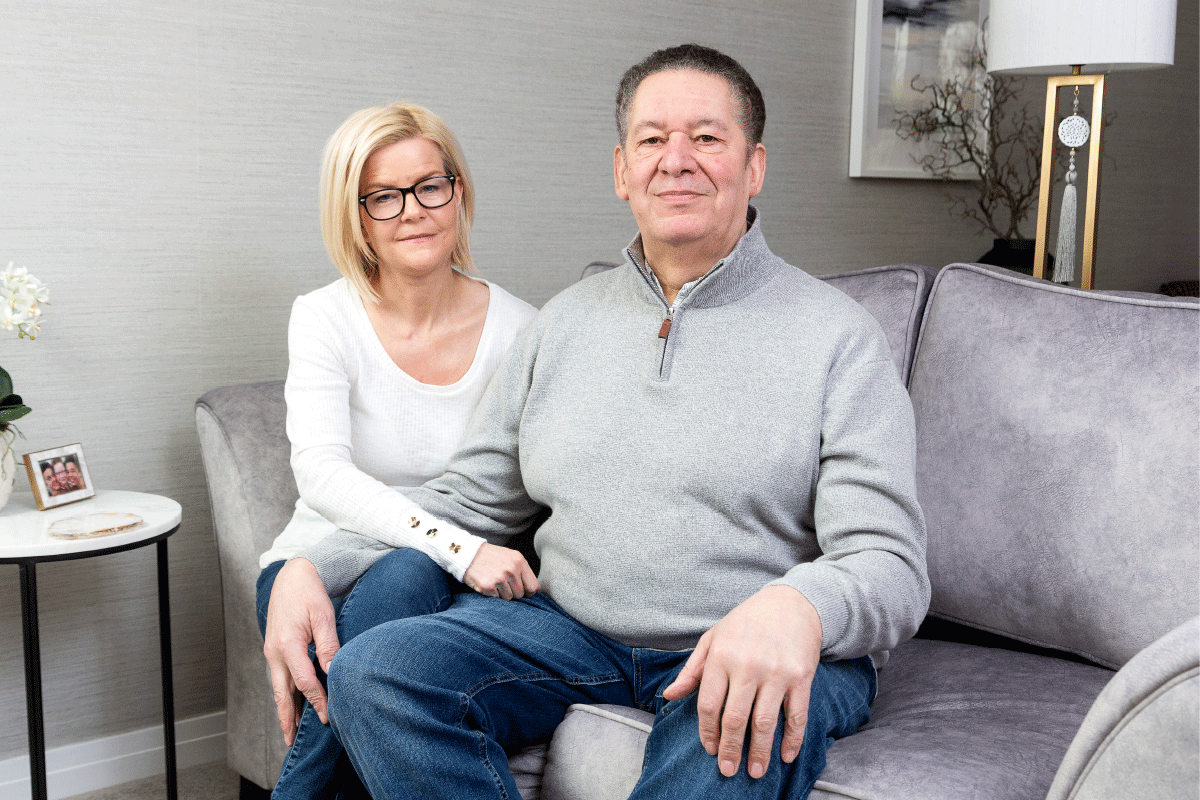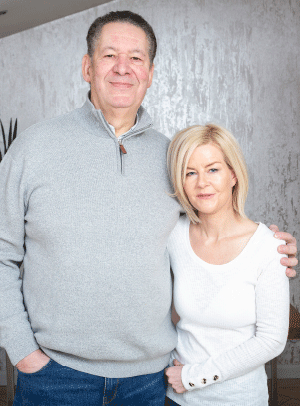Money makeover: how can we wind down our company and enjoy a comfortable retirement?
John and Joanne Davidson would like more time to relax, but they have a number of tax and pension issues…
4th May 2020 12:09
by Emma Lunn from interactive investor
John and Joanne Davidson would like more time to relax, but they have a number of tax and pension issues they need to resolve first

The Davidsons have been married for four years and both have children from previous relationships. The couple live in a mortgage-free home, worth £350,000, in The Wirral.
John, 66, had a successful career with Unilever from 1975 until his retirement in 2009. Since then, he has set up and run his own company, Supply Chain Designz.
Both John and Joanne draw a salary from the firm (John £6,432, and Joanne £11,500), plus dividends of £2,000 each a year. Turnover this tax year is expected to be £50,000, with profits after expenses of £28,000.
John says: “My intention is to wind down my company, drawing a salary and dividends for me and my wife while continuing to incur some business expenses until the accumulated funds in the business reduce to zero. This will amount to about £24,000 a year and, based on current funds of £160,000, will take around six to seven years. I also plan to draw on my pension savings as needed.”
John has a defined benefit pension with Unilever. Some of the benefit goes to his ex-wife as part of his divorce settlement, but it still provides a net income of £24,078 a year.
He also receives a state pension of £7,291 a year plus an Italian pension of €3,000 (about £2,550) and has accumulated approximately £230,000 in an interactive investor self-invested personal pension (SIPP).
Joanne, 50, stopped working three years ago and also has a Unilever defined benefit pension, which she expects to start taking in 2029. She will be entitled to her state pension of £7,972 a year in 2036, based on her current national insurance record. This will increase to £8,797 if she makes national insurance contributions until April 2023.
The couple spend about £50,000 a year, with £27,000 going on fixed costs and around £24,500 on non-essential spending.
As well as questions about the best way to wind down Supply Chain Designz, the Davidsons also need advice about pension planning and — with a 16-year age gap — are concerned about Joanne’s financial wellbeing should John die first.
Winding up the business

Moneywise partnered with financial advice firm The Private Office (TPO) to deliver a comprehensive financial report for John and Joanne. TPO partner and chartered financial planner Joseph O’Shea, above, met the Davidsons to discuss their financial goals.
O’Shea set out a number of potential options regarding closing down Supply Chain Designz. These include winding up the company and paying either entrepreneurs’ relief and/or capital gains tax (CGT) on the money withdrawn, paying salaries; making employer pension contributions; or drawing profits as dividends.
O’Shea says: “As a means of being able to quickly draw a line under the business, and of potentially benefiting from a 10% rate of CGT on the money withdrawn, we discussed winding up the business and withdrawing the full balance of funds immediately.
“We understand from our conversations, however, that your accountant has confirmed the full value withdrawn would not benefit from entrepreneurs’ relief, and that at least some of the capital withdrawn would potentially be subject to the full rate of CGT, currently 20%.”
With Joanne having little or no other taxable income, and not yet having accumulated the required 35 qualifying years to qualify for the full state pension, O’Shea suggests it may be prudent to pay Joanne a salary above the class-1 national insurance lower earnings level (currently £6,136 a year) and up to the primary threshold (currently £8,632).
“If salary is paid to Joanne at an appropriate level, it should mean the income is not subject to income tax nor employee national insurance,” he says.
Lifetime allowance issues
John says: “In an ideal world, I would have continued to move money from my business into my pension rather than leaving £160,000 languishing in a zero-interest business account for six years.”
John is concerned that this could force him to breach the lifetime allowance (currently £1,055,000, this limits the amount you can accrue in a pension over a lifetime), and incur punitive tax charges.
“The Pensions Advisory Service has suggested that there is no way around this, but I would like some advice to see if there are any creative options.”
But O’Shea believes that John does not currently have a lifetime allowance issue. Because John has been in receipt of his Unilever pension since 2009, a proportion of the prevailing Lifetime Allowance at that time (£1.75 million) was used.
Consequently, O’Shea says making a further employer pension contribution before the end of the 2019/20 tax year should be considered.
Drawing profits as dividends
The first £2,000 of dividend income received by an individual each year is tax-free. Dividends taken above this are taxed at the prevailing rates — currently 0% for non-taxpayers, 7.5% for basic-rate taxpayers, and 32.5% for higher-rate taxpayers.
O’Shea advises the Davidsons to continue paying dividends to themselves and to make sure Joanne’s personal allowance is used each year.
He says: “Given the relatively lower rate of tax applicable to dividends falling within the income tax basic-rate band when compared to salary (7.5% compared to 20%), were you to want to withdraw funds above the levels outlined above (pension contribution, salary and dividends), you may want to consider paying additional dividends rather than salary.”
Joanne’s financial future
O’Shea used a cash-flow modelling tool to forecast long-term income needs and planned expenditure to visualise, in particular, Joanne’s financial future, as she is likely to live longer than John. But although the couple’s financial outlook looks relatively strong, they admit they overspend and that means Joanne may face a shortfall when she is older.
O’Shea comments: “It is clear that investment and spending decisions made today have the potential to impact significantly on future financial peace of mind.
“Based on the assumptions used, unless spending plans are reduced, the cash-flow modelling suggests that returns on investments within your SIPP will be important. For this reason, we have analysed and provided commentary on the current investment strategy and provided some, what we hope will be, valuable insights.”
Investment matters

Although John believes, given his age, he should be adopting a cautious approach to his SIPP investments, he is actually taking a rather more adventurous approach. He monitors his portfolio daily and aims to time markets and then adopt a buy-and-hold strategy. His aim is to achieve a return of 5% above inflation.
John recently bought a range of single company shares and subsequently sold them following a drop in value. The proceeds are temporarily sitting in cash. Consequently, his SIPP is split into 54% cash, 10% bonds, 4% UK equities, and 32% global equities. Currently, investment exposure is provided through a number of exchange traded funds (ETFs), investment trusts and direct equities. Cash is held with a view to benefiting from market timing.
O’Shea says John’s SIPP portfolio is lacking in diversification. The portfolios TPO builds for its clients typically hold 20 different holdings (compared to John’s eight), diversified by asset type, geography, investment style, fund manager and fund house.
O’Shea says: “Direct equities are relatively higher risk as both systematic (market risk) and non-systematic risk (company/asset specific risk) are undiluted. In comparison, an investment fund or investment trust would generally have exposure of between 40 and 100 companies — diversifying and consequently reducing risk.”
Passing on pension funds
The SIPP will allow John to pass on the value of any remaining pension funds (less any tax or lifetime allowance charge applicable at the time) to Joanne and/or his children on his death. The pension fund will normally be exempt from inheritance tax.
O’Shea also encourages the Davidsons to consider how their wills and pensions will distribute assets on death, to ensure they are reflective of their current wishes and intentions. This is particularly important for couples with children from previous relationships.
He also recommends that the Davidsons each set up a lasting power of attorney. This would ensure that if either party lost mental capacity, a trusted family member or friend could make decisions on their behalf.
How did they find the Money Makeover?
Overall, John says he was happy with TPO’s advice.
“One of my main questions was how to take money out of the business. I think by following TPO’s advice about paying more money to my wife, I’ll save about £16,000 over the time period.”
However, John is worried that at his age he hasn’t got time to ride out volatility in the stock market.
“I realise that there are a number of factors such as how I invest within my SIPP that will affect the outcome. But for now I am happy to invest on my own behalf until I prove to myself that paying someone else to do it might be a better way, at which point the TPO or another independent financial adviser might come back into play.
“If I had 30 years to invest I’m sure they would be a positive net outcome, but I haven’t got that long to wait. I think more diversification is great, in general, but not for me at the moment.”
Key recommendations for John and Joanne
• Adjust how money is withdrawn from the company, including making further employer pension contributions, to improve tax efficiency and potentially improve Joanne’s state pension entitlement
• Review the pension investment strategy to ensure it is aligned with needs, goals, attitude to risk and investment time horizons
• Review their wills and consider setting up lasting powers of attorney for each of them

Up your personal finances game with a Money Makeover
Are your finances in need of an overhaul? The Money Makeover is here to help transform the finances of Moneywise readers – one reader at a time.
We arrange a one-to-one meeting with an FCA-regulated independent financial adviser for you in your local area, who will discuss your financial concerns and goals for the future, and draw up a bespoke financial plan for you. Our partner, TPO, is qualified to provide strategic advice and specific product recommendations for all areas of financial planning, and explain the basics of shedding debts, budgeting and saving, pension saving, building an investment portfolio and inheritance tax planning.
You will receive a copy of the adviser’s report. Of course, it’s up to you whether you follow their advice. The Money Makeover is totally free – all we ask is that you are comfortable with your personal financial details and photos being published in Moneywise, so that our readers can also learn from the advice you receive.
To apply for your makeover, fill in the form at Moneywise.co.uk/money-makeover or email editor@moneywise.co.uk.
This article was originally published in our sister magazine Moneywise, which ceased publication in August 2020.
These articles are provided for information purposes only. Occasionally, an opinion about whether to buy or sell a specific investment may be provided by third parties. The content is not intended to be a personal recommendation to buy or sell any financial instrument or product, or to adopt any investment strategy as it is not provided based on an assessment of your investing knowledge and experience, your financial situation or your investment objectives. The value of your investments, and the income derived from them, may go down as well as up. You may not get back all the money that you invest. The investments referred to in this article may not be suitable for all investors, and if in doubt, an investor should seek advice from a qualified investment adviser.
Full performance can be found on the company or index summary page on the interactive investor website. Simply click on the company's or index name highlighted in the article.